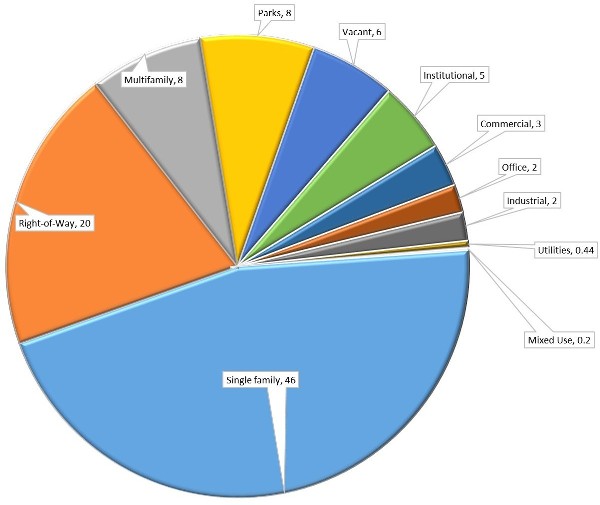A. Introduction
Kirkland’s existing pattern of land use has served the City well for many years. Over the next 20 years, the real challenge for the community will be how to preserve existing community character in the face of continued population and employment growth.
Kirkland is part of a regional and interrelated pattern of land uses. Most land in the City is devoted to housing, and the majority of Kirkland residents commute to other communities to work.
The following Table LU-1 shows the percentage of land uses based on the City’s total land area in 2013:
Table LU-1: 2013 – Land Use by Percent of the City’s Total Land Area
Source: City of Kirkland and PSRC estimates
Kirkland is also a balanced community, providing shops, services and employment both for local residents and for those who live in other communities.
Kirkland is also a city of neighborhoods – each with its own mix of population, housing, commercial opportunities, and visual features which help form its unique character. The City’s residential neighborhoods are generally strong and well established. They are also diverse in housing type, size, style, history, maturity and affordability. More mixed-use residential/commercial centers have developed, including Juanita Village and Downtown Kirkland.
The commercial areas are healthy, offer a broad range of goods and services, and provide a strong tax base to help fund public services and facilities. Kirkland has a diverse economic base with several retail centers, mixed-use retail/office districts, a regional health care center, auto dealerships, business parks, industrial complexes and home-based businesses.
More information on existing land uses can be found in the City’s Community Profile document available in the Planning Department at Kirkland City Hall.
Between 2013 and 2035, the City will grow by nearly 8,361 new housing units and 22,435 jobs. These projections are referred to as “growth targets.” Under the Growth Management Act, planning policies seek to direct growth to existing and emerging urban areas within the metropolitan region. The King County Growth Management Planning Council allocates growth targets to jurisdictions and Kirkland is responsible for planning for the increased needs for housing, commercial floorspace, and public services.
Future growth will raise other issues relating to land use: special needs housing, increased traffic congestion, pressure on natural resources and challenges to locate regional facilities. A larger proportion of elderly residents will focus new attention on the special housing and transportation needs of this group. Land use relationships which support transit and provide shops and services closer to home will be important for those with decreased mobility. And, with growth not only in Kirkland, but throughout the Puget Sound region, the community will continue to suffer from the problems of traffic congestion, diminishing natural resources, and the need to find locations for new regional facilities. Regional solutions will be needed to solve these problems.
Issues which must be addressed by the Land Use Element include:
♦ How to plan for the 2035 housing unit and employment growth targets established by the King County Growth Management Planning Council.
♦ How to manage the new growth to protect the residential character of the community, while allowing for new and innovative development that responds to changing household needs.
♦ How to provide for a diversity of employment opportunities and maintain viable commercial areas.
♦ How to use the pattern of land use to minimize traffic congestion and protect local air quality.
♦ How to maintain a land use pattern that can be efficiently and effectively served by public services and utilities.
♦ How to protect Kirkland’s environmentally sensitive areas, open space corridors, drainage basins, steep slopes, and shoreline as new housing units and commercial floorspace are developed.
♦ How to respond to the regional responsibility to help site new regional facilities.
The Land Use Element works together with the other elements of the Comprehensive Plan to answer these questions. While the Land Use Element addresses accommodating growth and sets out general residential siting criteria, the Housing Element more specifically addresses issues of neighborhood character, affordability, and special needs housing.
The Transportation Element identifies the improvements needed to support the land use pattern established by the Land Use Element.
Growth management concerns identified in this element, such as preservation of community character, relationship to the natural environment, and adequate public and human services, are amplified in the Community Character, Natural Environment, Parks and Recreation, Capital Facilities, Human Services, Utilities, and Public Services Elements.
Finally, the Land Use Element’s discussion of commercial areas is strongly tied to the Economic Development Element. Kirkland’s goal to “strengthen the unique role and economic success of Kirkland’s commercial areas” (Economic Development Goal ED-3) is echoed in the Land Use Element.


